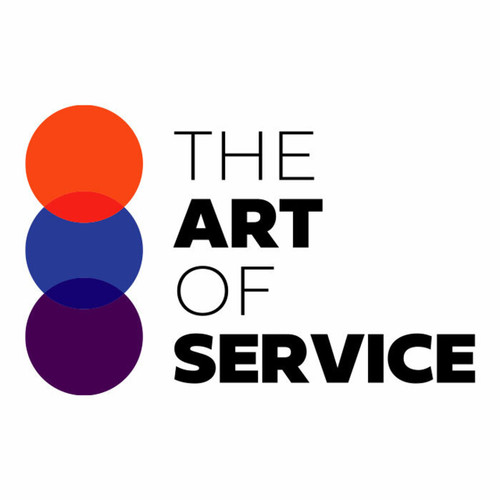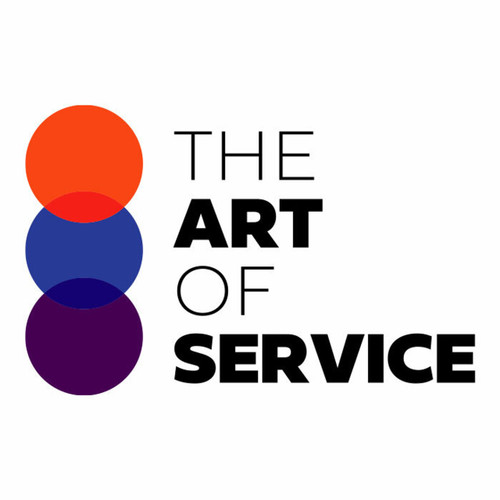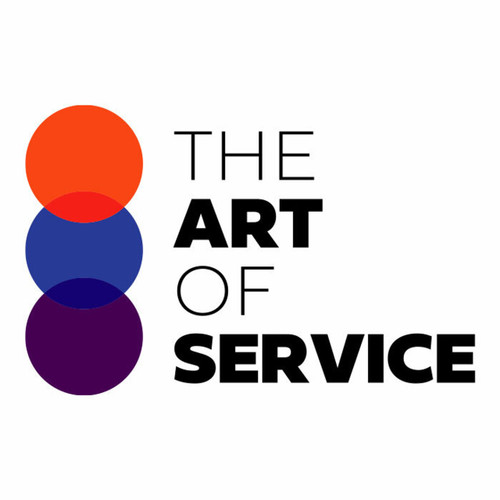Are you tired of struggling with prioritizing and addressing problems in your business? Look no further.
Our Top Management and Failure Mode and Effects Analysis Knowledge Base is here to revolutionize the way you approach problem-solving.
Our Knowledge Base consists of 1501 carefully curated prioritized requirements, solutions, benefits, results, and real-life case studies from companies who have successfully implemented our methods.
Packed with the most important questions to ask by urgency and scope, this Knowledge Base will guide you towards making informed and efficient decisions for your business.
What sets our Top Management and Failure Mode and Effects Analysis Knowledge Base apart from competitors and alternatives? We offer a comprehensive and detailed dataset that specifically caters to top management professionals.
Our product is affordable and can be easily used without the need for expensive consultants or advisors.
With our product, you can streamline your problem-solving process and save time and resources.
Our top-of-the-line data will equip you with the necessary tools to make strategic decisions that will drive your business towards success.
No more wasting time and money on trial-and-error methods, our Knowledge Base has been extensively researched and tested to ensure its effectiveness.
Businesses of all sizes can benefit from our Top Management and Failure Mode and Effects Analysis Knowledge Base.
From small startups to large corporations, our product is designed to help businesses of all types and industries.
Don′t let problems hold your business back any longer, invest in our Knowledge Base and see the results for yourself.
But don′t just take our word for it, try it out for yourself and see the difference it makes in your business.
Our Knowledge Base is available for a reasonable cost, making it a worthwhile investment for any business looking to improve their problem-solving processes.
In today′s dynamic and fast-paced business world, top management professionals need the best tools to stay ahead of the competition.
And that′s exactly what our Top Management and Failure Mode and Effects Analysis Knowledge Base offers - a powerful and effective way to address problems and make data-driven decisions.
Don′t let problems linger and affect your business′s success.
Invest in our Top Management and Failure Mode and Effects Analysis Knowledge Base and take control of your business′s future.
With detailed product specifications and a clear description of what it does, you can trust that our Knowledge Base is the right choice for your business.
Purchase now and see the difference it makes in your problem-solving process.
Discover Insights, Make Informed Decisions, and Stay Ahead of the Curve:
Key Features:
Comprehensive set of 1501 prioritized Top Management requirements. - Extensive coverage of 100 Top Management topic scopes.
- In-depth analysis of 100 Top Management step-by-step solutions, benefits, BHAGs.
- Detailed examination of 100 Top Management case studies and use cases.
- Digital download upon purchase.
- Enjoy lifetime document updates included with your purchase.
- Benefit from a fully editable and customizable Excel format.
- Trusted and utilized by over 10,000 organizations.
- Covering: Reliability Targets, Design for Manufacturability, Board Best Practices, Effective Presentations, Bias Identification, Power Outages, Product Quality, Innovation, Distance Working, Mistake Proofing, IATF 16949, Strategic Systems, Cause And Effect Analysis, Defect Prevention, Control System Engineering, Casing Design, Probability Of Failure, Preventive Actions, Quality Inspection, Supplier Quality, FMEA Analysis, ISO 13849, Design FMEA, Autonomous Maintenance, SWOT Analysis, Failure Mode and Effects Analysis, Performance Test Results, Defect Elimination, Software Applications, Cloud Computing, Action Plan, Product Implementation, Process Failure Modes, Introduce Template Method, Failure Mode Analysis, Safety Regulations, Launch Readiness, Inclusive Culture, Project communication, Product Demand, Probability Reaching, Product Expertise, IEC 61508, Process Control, Improved Speed, Total Productive Maintenance, Reliability Prediction, Failure Rate, HACCP, Failure Modes Effects, Failure Mode Analysis FMEA, Implement Corrective, Risk Assessment, Lean Management, Six Sigma, Continuous improvement Introduction, Design Failure Modes, Baldrige Award, Key Responsibilities, Risk Awareness, DFM Training, Supplier Failures, Failure Modes And Effects Analysis, Design for Serviceability, Machine Modifications, Fault Tree Analysis, Failure Occurring, Hardware Interfacing, ISO 9001, Common Cause Failures, FMEA Tools, Failure modes, DFM Process, Affinity Diagram, Key Projects, System FMEA, Pareto Chart, Risk Response, Criticality Analysis, Process Controls, Pressure Sensors, Work Instructions, Risk Reduction, Flowchart Software, Six Sigma Techniques, Process Changes, Fail Safe Design, DFM Integration, IT Systems, Common Mode Failure, Process FMEA, Customer Demand, BABOK, Manufacturing FMEA, Renewable Energy Credits, Activity Network Diagram, DFM Techniques, FMEA Implementation, Security Techniques, Top Management, Failure Acceptance, Critical Decision Analysis
Top Management Assessment Dataset - Utilization, Solutions, Advantages, BHAG (Big Hairy Audacious Goal):
Top Management
Effective communication methods include clear and concise reports, presentations, meetings, and regular updates on project progress.
1. Conduct regular meetings with top management to discuss progress and potential concerns.
- Benefits: Allows for open communication and transparency, ensures that top management is aware of any issues that may arise.
2. Provide top management with detailed reports outlining the potential failures and their effects.
- Benefits: Provides a comprehensive overview of the development concerns, allowing top management to make informed decisions.
3. Collaborate with top management to establish contingency plans in case of failure.
- Benefits: Ensures that top management is part of the risk management process and prepared to address potential failures.
4. Involve top management in the prioritization of tasks based on severity of potential failures.
- Benefits: Ensures that top management is aware of the most critical development concerns and can prioritize accordingly.
5. Utilize visual aids, such as charts or diagrams, to effectively communicate the main development concerns to top management.
- Benefits: Can help simplify complex information and make it easier for top management to understand and address concerns.
6. Encourage top management to have an open-door policy for team members to express any concerns or suggestions.
- Benefits: Creates a culture of open communication and empowers team members to voice their concerns and contribute to finding solutions.
7. Regularly update top management on any changes or improvements made to address development concerns.
- Benefits: Demonstrates progress being made and keeps top management informed and involved in the development process.
CONTROL QUESTION: How do you communicate the main development concerns to top management?
Big Hairy Audacious Goal (BHAG) for 10 years from now:
The big hairy audacious goal for Top Management 10 years from now is to become the global leader in sustainable and ethical business practices, while achieving long-term profitability and positively impacting society.
To communicate the main development concerns to top management, the following steps will be taken:
1. Create a clear and comprehensive sustainability strategy: This strategy will outline the company′s commitment to sustainable development, identify key focus areas, and set specific targets and timelines for achieving them.
2. Establish regular communication channels: Top management will have open and transparent communication channels with all levels of the organization. This will include regular town hall meetings, newsletters, and intranet updates to ensure information is disseminated effectively.
3. Embed sustainability into decision-making processes: The development concerns will be integrated into all business decisions, including strategic planning, budgeting, and resource allocation.
4. Provide data and evidence: Top management will be presented with data and evidence to support the identified development concerns. This will include market trends, stakeholder expectations, and industry best practices.
5. Conduct regular sustainability reporting: The company will produce a comprehensive sustainability report that highlights progress and challenges in addressing the development concerns. This report will be shared with top management and other stakeholders.
6. Foster a culture of transparency and accountability: Top management will be encouraged to lead by example and hold themselves accountable for driving sustainable development initiatives within the organization.
7. Collaborate with external partners: The company will engage with external partners, such as NGOs, government agencies, and other businesses, to gain insights and collaborate on solutions for the identified development concerns.
By following these steps, top management will have a deep understanding of the company′s development concerns and the necessary actions to address them effectively. This will enable them to lead the organization towards sustainable and ethical growth, creating a positive impact on both business and society.
Customer Testimonials:
"I`ve been searching for a dataset like this for ages, and I finally found it. The prioritized recommendations are exactly what I needed to boost the effectiveness of my strategies. Highly satisfied!"
"This dataset is a treasure trove for those seeking effective recommendations. The prioritized suggestions are well-researched and have proven instrumental in guiding my decision-making. A great asset!"
"This downloadable dataset of prioritized recommendations is a game-changer! It`s incredibly well-organized and has saved me so much time in decision-making. Highly recommend!"
Top Management Case Study/Use Case example - How to use:
Client Situation:
The client, a multinational corporation in the technology industry, has been experiencing rapid growth and expansion in recent years. With an increasing focus on innovation and product development, the company is constantly facing new challenges in meeting customer demands and staying ahead of competitors. As a result, the top management is constantly seeking updates on development concerns, including process improvements, resource allocation, and technology advancements, to ensure continued success.
Consulting Methodology:
To effectively communicate the main development concerns to top management, our consulting firm utilized a multi-step methodology that incorporated research, data analysis, and strategic communication techniques. The following steps were taken:
1. Data Collection: This step involved gathering relevant data from various sources, including internal reports and surveys, market research reports, and industry publications. This helped to establish a comprehensive overview of the key development concerns within the organization.
2. Analysis: The collected data was then analyzed to identify trends, patterns, and areas of improvement. This step allowed us to prioritize the most critical development concerns and understand their impact on the organization.
3. Stakeholder Interviews: We conducted interviews with key stakeholders, including department heads, project managers, and team leaders, to gather first-hand insights and perspectives on the identified development concerns. This helped to validate our findings and gather additional information that may not have been captured through data analysis.
4. Presentation Preparation: Based on the data analysis and stakeholder interviews, we prepared a comprehensive presentation that summarised the main development concerns and their impact on the organization. This included visual aids, such as graphs and charts, to convey the information effectively.
5. Strategic Communication: Finally, we presented the findings to the top management through a strategic communication plan. This involved tailoring the message to the specific needs and priorities of the top management, using language and examples that resonated with them.
Deliverables:
The main deliverable from this consulting engagement was a comprehensive presentation that highlighted the top development concerns and their potential impact on the organization. This was accompanied by a detailed report that included our methodology, analysis, and recommendations for addressing the identified concerns. The presentation and report were designed to be easily digestible and actionable for the top management.
Implementation Challenges:
One of the main challenges faced during this engagement was ensuring that the message was effectively communicated to top management. This involved understanding their mindset and priorities, and tailoring the message accordingly. Another challenge was prioritizing the development concerns, as there were multiple areas that required attention. However, through our data-driven approach and stakeholder interviews, we were able to identify the most critical concerns and present them in a clear and concise manner.
Key Performance Indicators (KPIs):
The success of this consulting engagement was measured through several KPIs, including:
1. Implementation of Recommendations: The number of recommendations implemented by the organization following the presentation and report.
2. Employee Satisfaction: The level of satisfaction among employees regarding the company′s response to development concerns.
3. Impact on Business Performance: The impact of addressing the identified development concerns on the overall performance of the organization.
Management Considerations:
To ensure the continued success of the organization and effective communication of development concerns to top management, the following management considerations should be kept in mind:
1. Regular Updates: It is important to regularly update top management on development concerns and progress made in addressing them. This will help to maintain transparency and ensure that top management remains informed and involved in the process.
2. Incorporate Feedback: Top management should actively listen to employee and departmental feedback regarding development concerns, and incorporate it into decision-making processes. This will help to create a culture of open communication and collaboration within the organization.
3. Allocate Resources Appropriately: To address development concerns effectively, it is important to allocate appropriate resources, including funding and personnel. Top management should prioritize addressing these concerns and ensure that the necessary resources are available.
In conclusion, effective communication of development concerns to top management is crucial for the success and growth of any organization. Our consulting firm was able to utilize a comprehensive methodology to understand and prioritize these concerns and present them to top management in a clear and actionable manner. By implementing our recommendations and considering management considerations, the organization can ensure that it remains at the forefront of innovation and development in its industry.
Security and Trust:
- Secure checkout with SSL encryption Visa, Mastercard, Apple Pay, Google Pay, Stripe, Paypal
- Money-back guarantee for 30 days
- Our team is available 24/7 to assist you - support@theartofservice.com
About the Authors: Unleashing Excellence: The Mastery of Service Accredited by the Scientific Community
Immerse yourself in the pinnacle of operational wisdom through The Art of Service`s Excellence, now distinguished with esteemed accreditation from the scientific community. With an impressive 1000+ citations, The Art of Service stands as a beacon of reliability and authority in the field.Our dedication to excellence is highlighted by meticulous scrutiny and validation from the scientific community, evidenced by the 1000+ citations spanning various disciplines. Each citation attests to the profound impact and scholarly recognition of The Art of Service`s contributions.
Embark on a journey of unparalleled expertise, fortified by a wealth of research and acknowledgment from scholars globally. Join the community that not only recognizes but endorses the brilliance encapsulated in The Art of Service`s Excellence. Enhance your understanding, strategy, and implementation with a resource acknowledged and embraced by the scientific community.
Embrace excellence. Embrace The Art of Service.
Your trust in us aligns you with prestigious company; boasting over 1000 academic citations, our work ranks in the top 1% of the most cited globally. Explore our scholarly contributions at: https://scholar.google.com/scholar?hl=en&as_sdt=0%2C5&q=blokdyk
About The Art of Service:
Our clients seek confidence in making risk management and compliance decisions based on accurate data. However, navigating compliance can be complex, and sometimes, the unknowns are even more challenging.
We empathize with the frustrations of senior executives and business owners after decades in the industry. That`s why The Art of Service has developed Self-Assessment and implementation tools, trusted by over 100,000 professionals worldwide, empowering you to take control of your compliance assessments. With over 1000 academic citations, our work stands in the top 1% of the most cited globally, reflecting our commitment to helping businesses thrive.
Founders:
Gerard Blokdyk
LinkedIn: https://www.linkedin.com/in/gerardblokdijk/
Ivanka Menken
LinkedIn: https://www.linkedin.com/in/ivankamenken/







